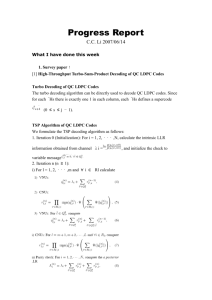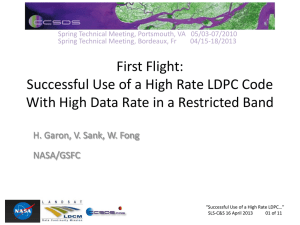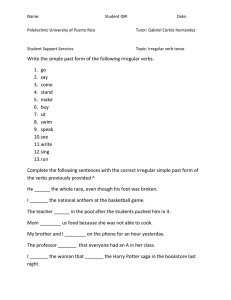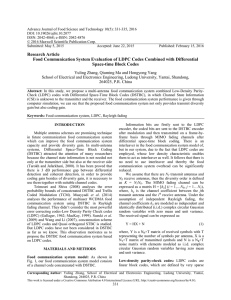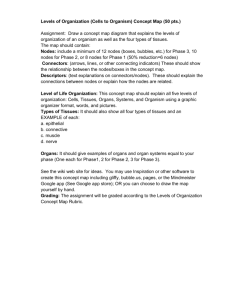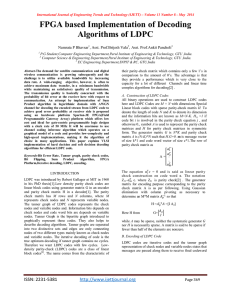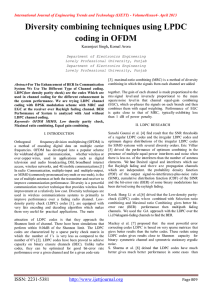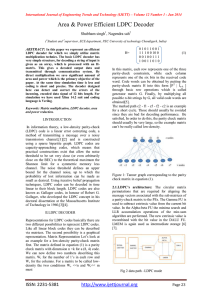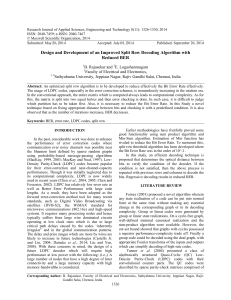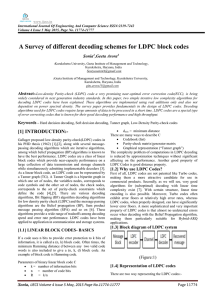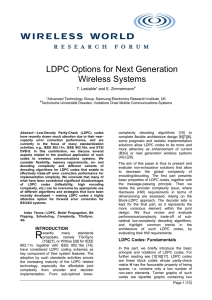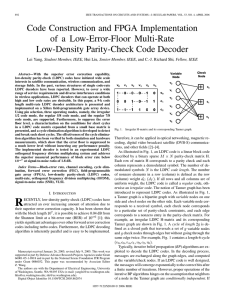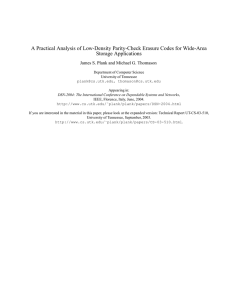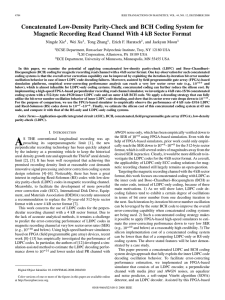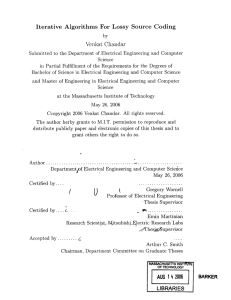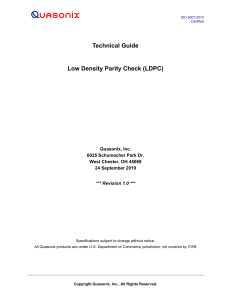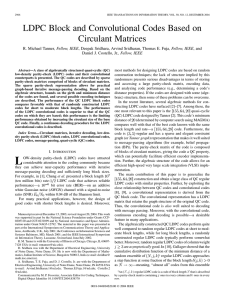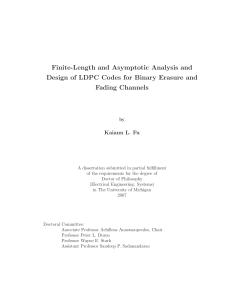Lecture 36: LDPC Codes Round-up
advertisement
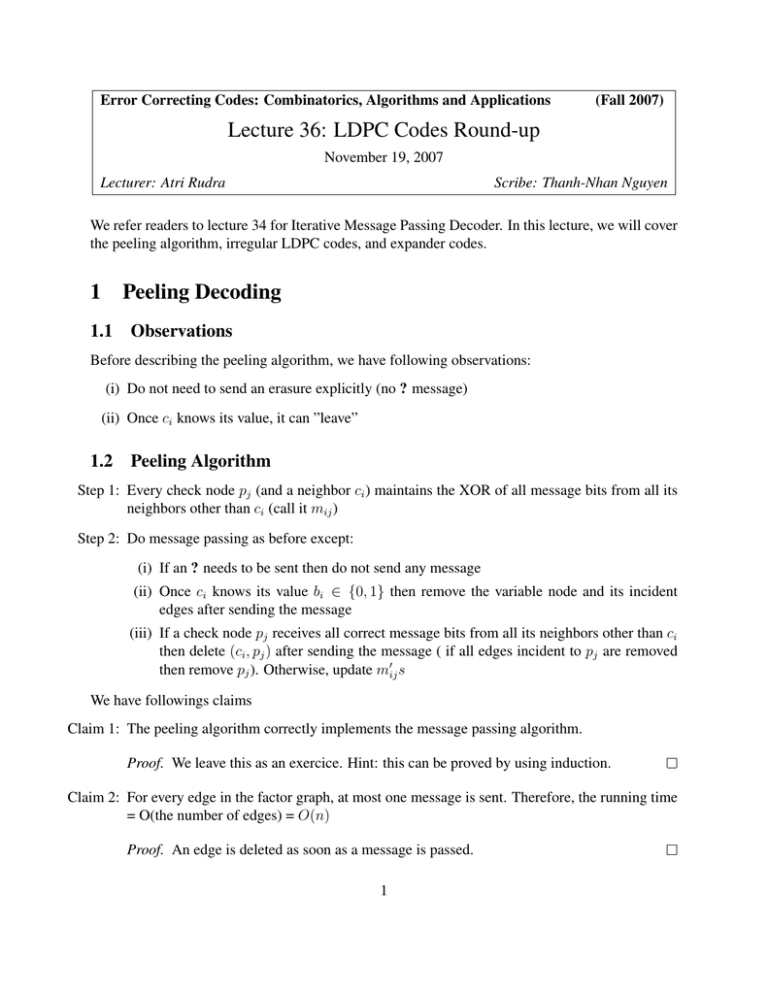
Error Correcting Codes: Combinatorics, Algorithms and Applications
(Fall 2007)
Lecture 36: LDPC Codes Round-up
November 19, 2007
Lecturer: Atri Rudra
Scribe: Thanh-Nhan Nguyen
We refer readers to lecture 34 for Iterative Message Passing Decoder. In this lecture, we will cover
the peeling algorithm, irregular LDPC codes, and expander codes.
1
Peeling Decoding
1.1
Observations
Before describing the peeling algorithm, we have following observations:
(i) Do not need to send an erasure explicitly (no ? message)
(ii) Once ci knows its value, it can ”leave”
1.2
Peeling Algorithm
Step 1: Every check node pj (and a neighbor ci ) maintains the XOR of all message bits from all its
neighbors other than ci (call it mij )
Step 2: Do message passing as before except:
(i) If an ? needs to be sent then do not send any message
(ii) Once ci knows its value bi ∈ {0, 1} then remove the variable node and its incident
edges after sending the message
(iii) If a check node pj receives all correct message bits from all its neighbors other than ci
then delete (ci , pj ) after sending the message ( if all edges incident to pj are removed
then remove pj ). Otherwise, update m0ij s
We have followings claims
Claim 1: The peeling algorithm correctly implements the message passing algorithm.
Proof. We leave this as an exercice. Hint: this can be proved by using induction.
Claim 2: For every edge in the factor graph, at most one message is sent. Therefore, the running time
= O(the number of edges) = O(n)
Proof. An edge is deleted as soon as a message is passed.
1
2
Irregular LDPC codes
Regular LDPC codes do not achieve BECα capacity. Yet, Luby et. al showed that irregular LDPC
codes do! Note that with irregular LDPC codes all nodes on left (or right) do not have the same
degree.
We observe that: for variable nodes, having more neighbors is better as chance of getting the
correct bit is higher. For check nodes, having less neighbors is better as chance of getting ? is
lower. Then, dv should be larger, and dc should be smaller. Or, the number of check nodes is
greater than the number of variable nodes. In this case, it is impossible to get positive rate 1 − ddvc .
With irregular LDPC codes, we have more freedom to achieve: the number of check nodes ≥ the
number of variable nodes.
Intuition for better performance: Variable nodes with high degree imply faster convergence to
correct bit value. Then, its neighbor check nodes get the correct bit value faster. And, variable
nodes with small degree get correct value faster.
Theorem 2.1. Can get within ε of capacity of BECα with encoding and decoding time of O(n lg( 1ε ))
However, it is not an explicit construction but a randomized construction.
For BSCp , work well experimentally, but no theoretical guarantees known.
Open questions:
1. Explicit irregular LDPC codes that achieve BECα capacity.
2. Prove theoretically that irregular LDPC code achieve BSCp capacity.
3
Expander Codes
Expander codes are explicit regular LDPC codes. Factor graph is an “expander” graph.
Denote S a subset with |S| ≤ n/2. Expander property:
|r(S)| ≥ Ω(d|S|)
where r(S) is the set of all neighbor of S.
3.1
Properties
1. This is a explicit asymptotically good (binary) codes, the only such codes that we are not
based on code concatenation
2. Expander codes can correct some p > 0 worst-case errors in linear time (message passing
algorithm)
3. Encoding is linear time
2
